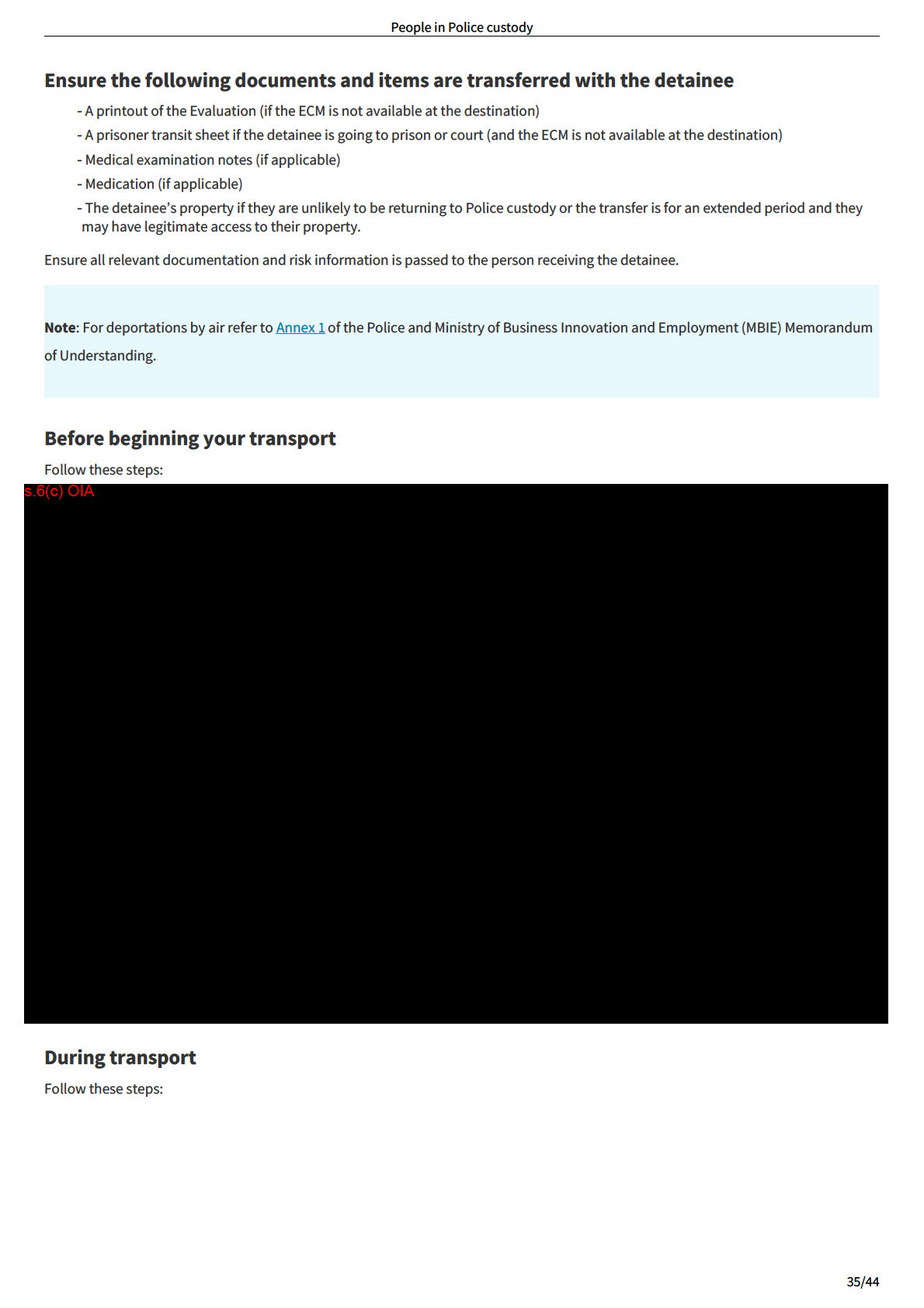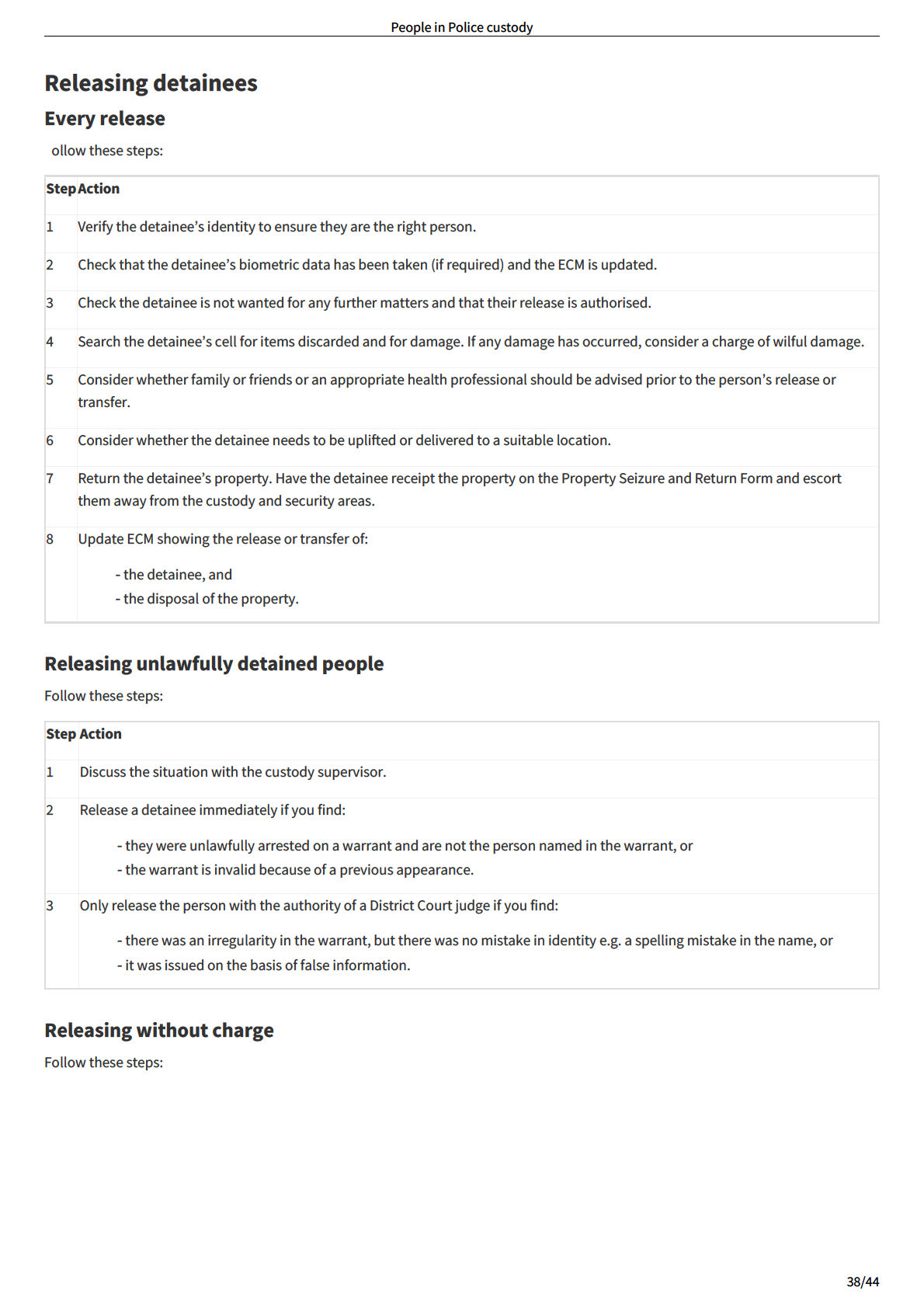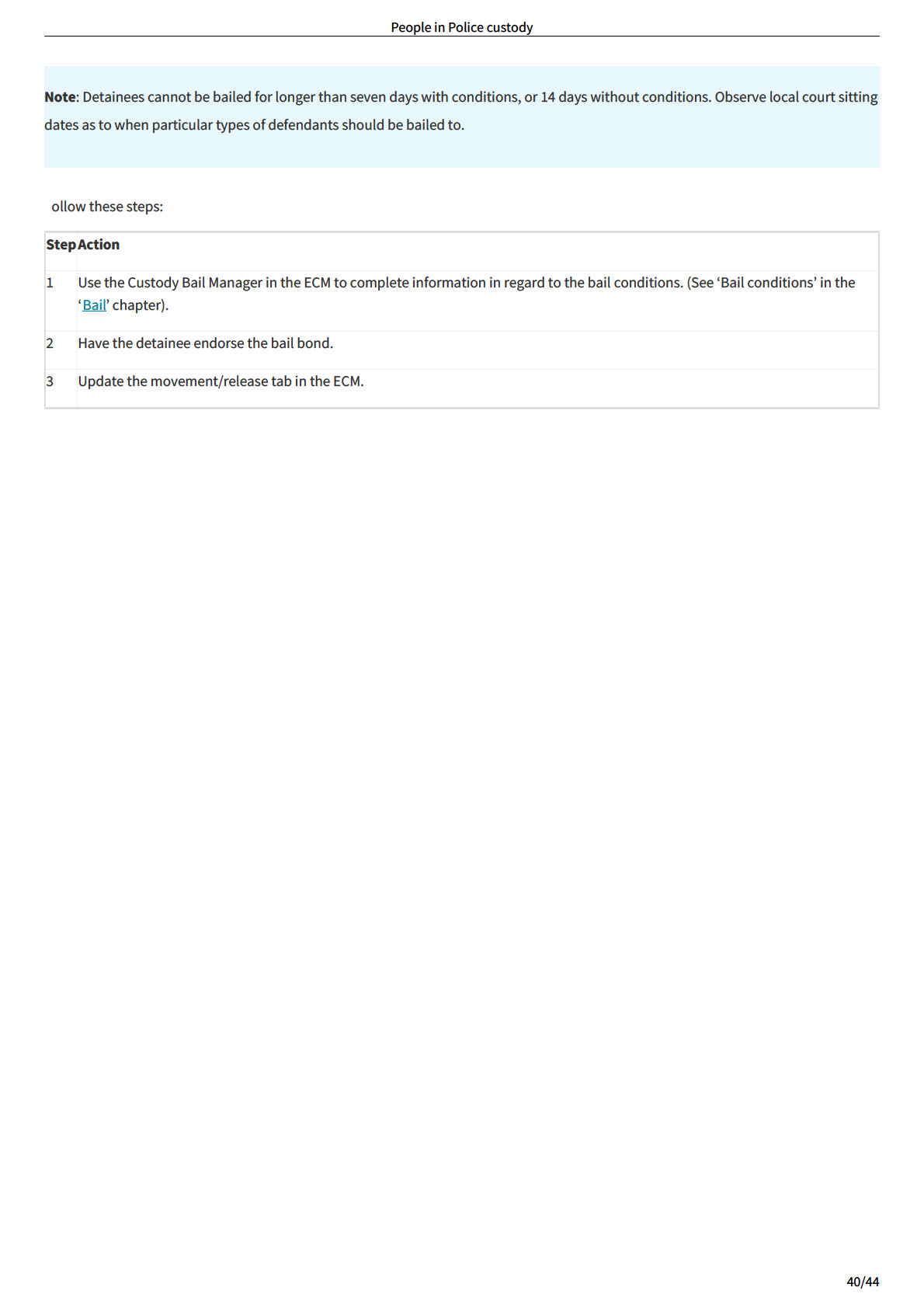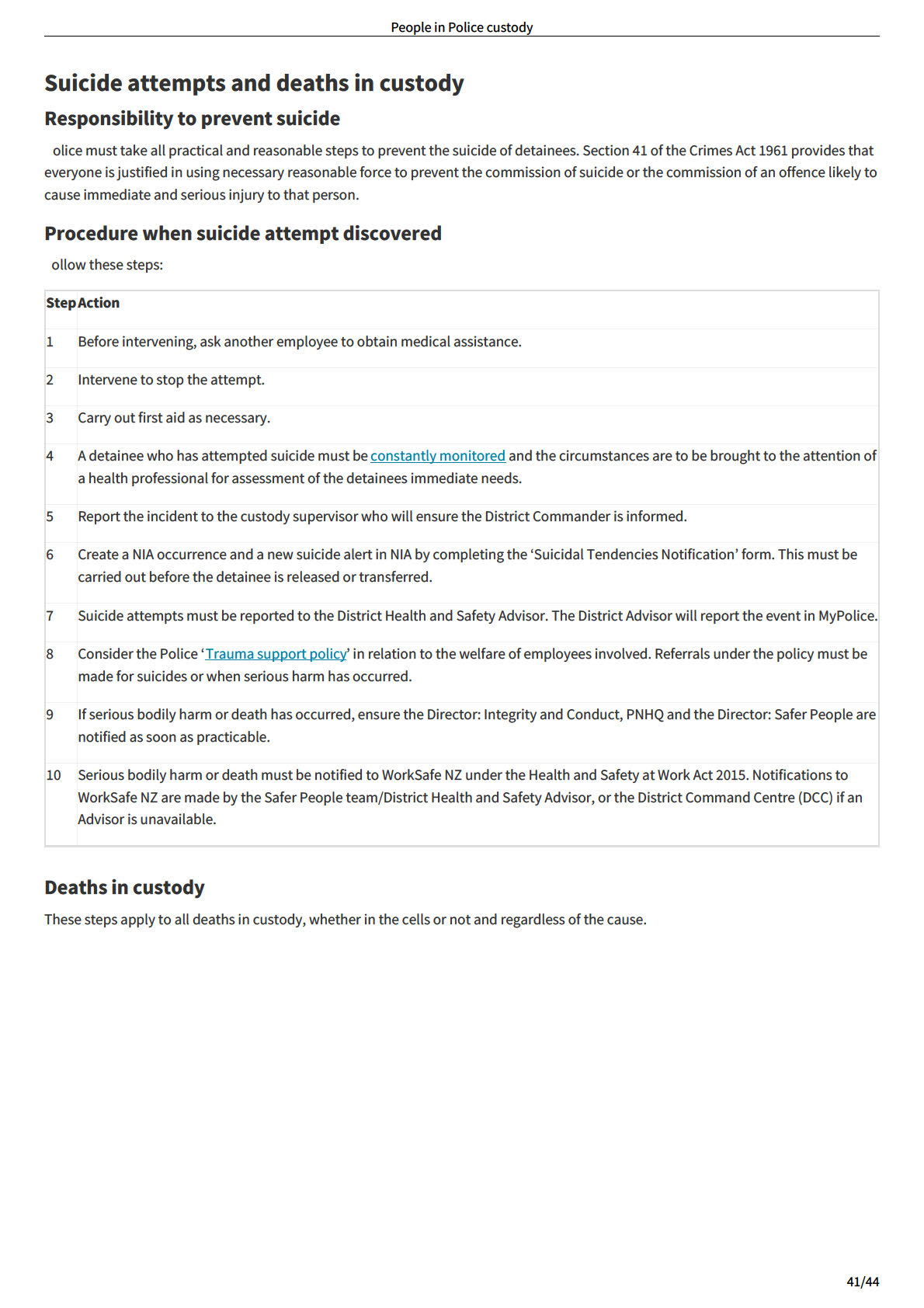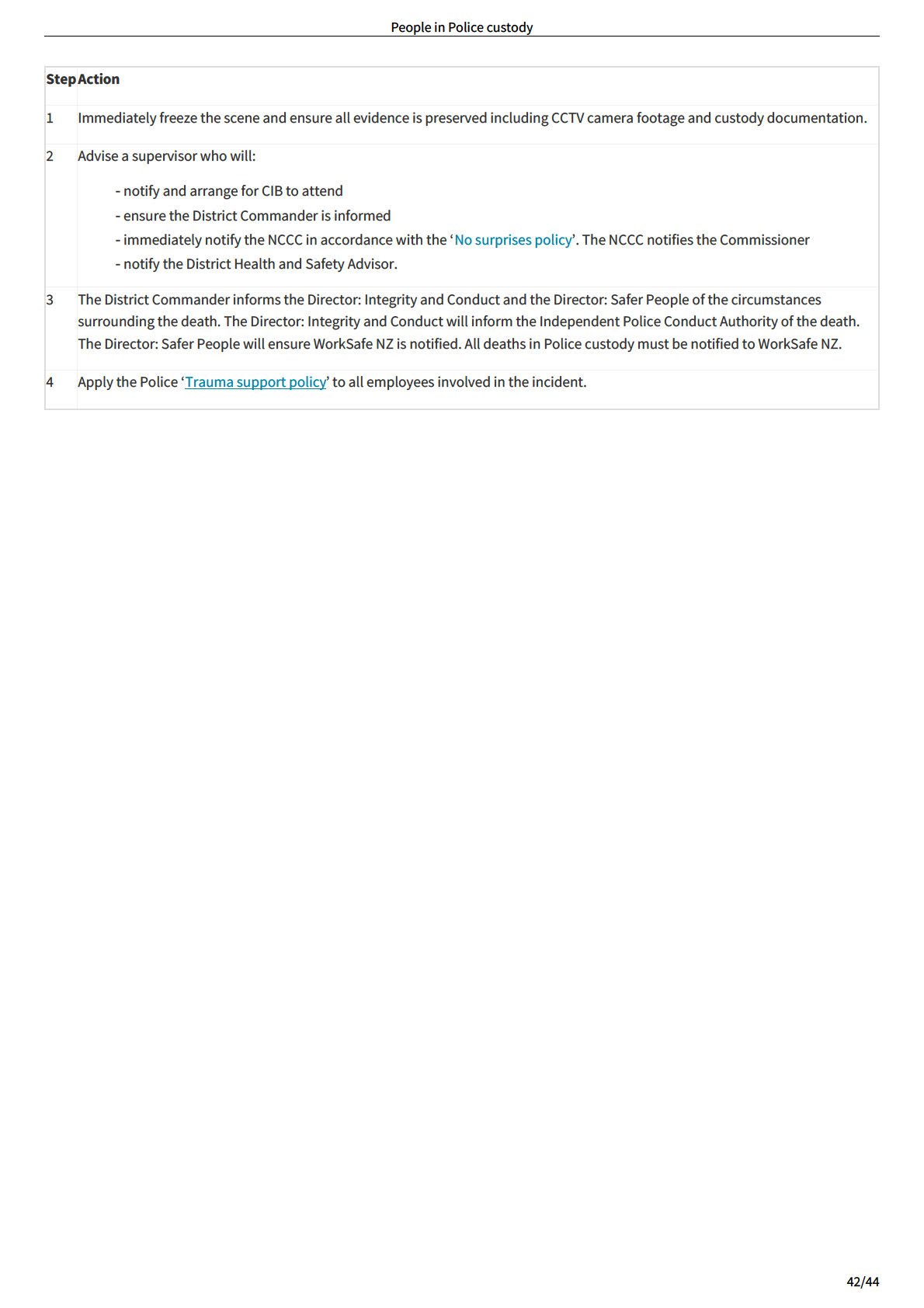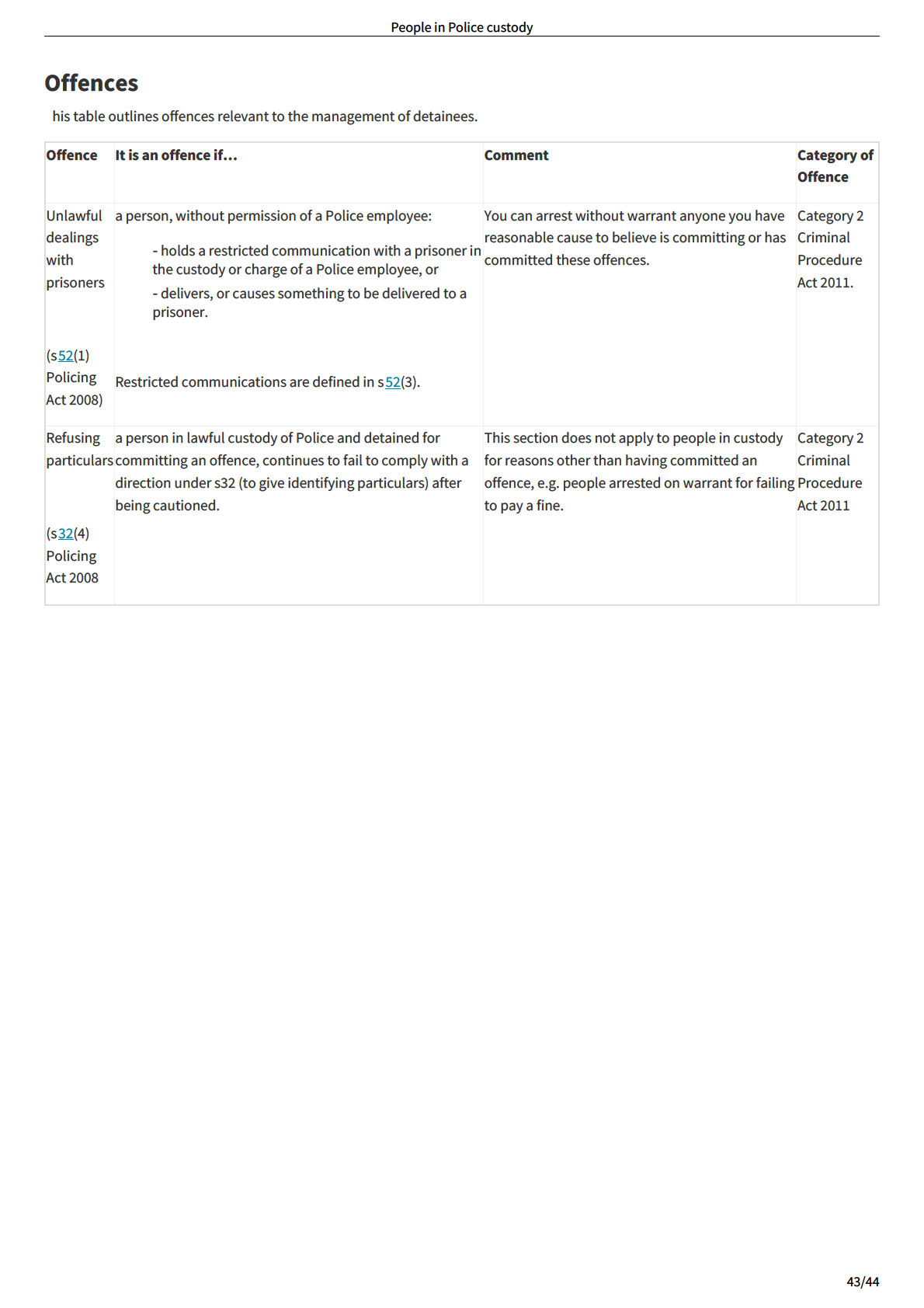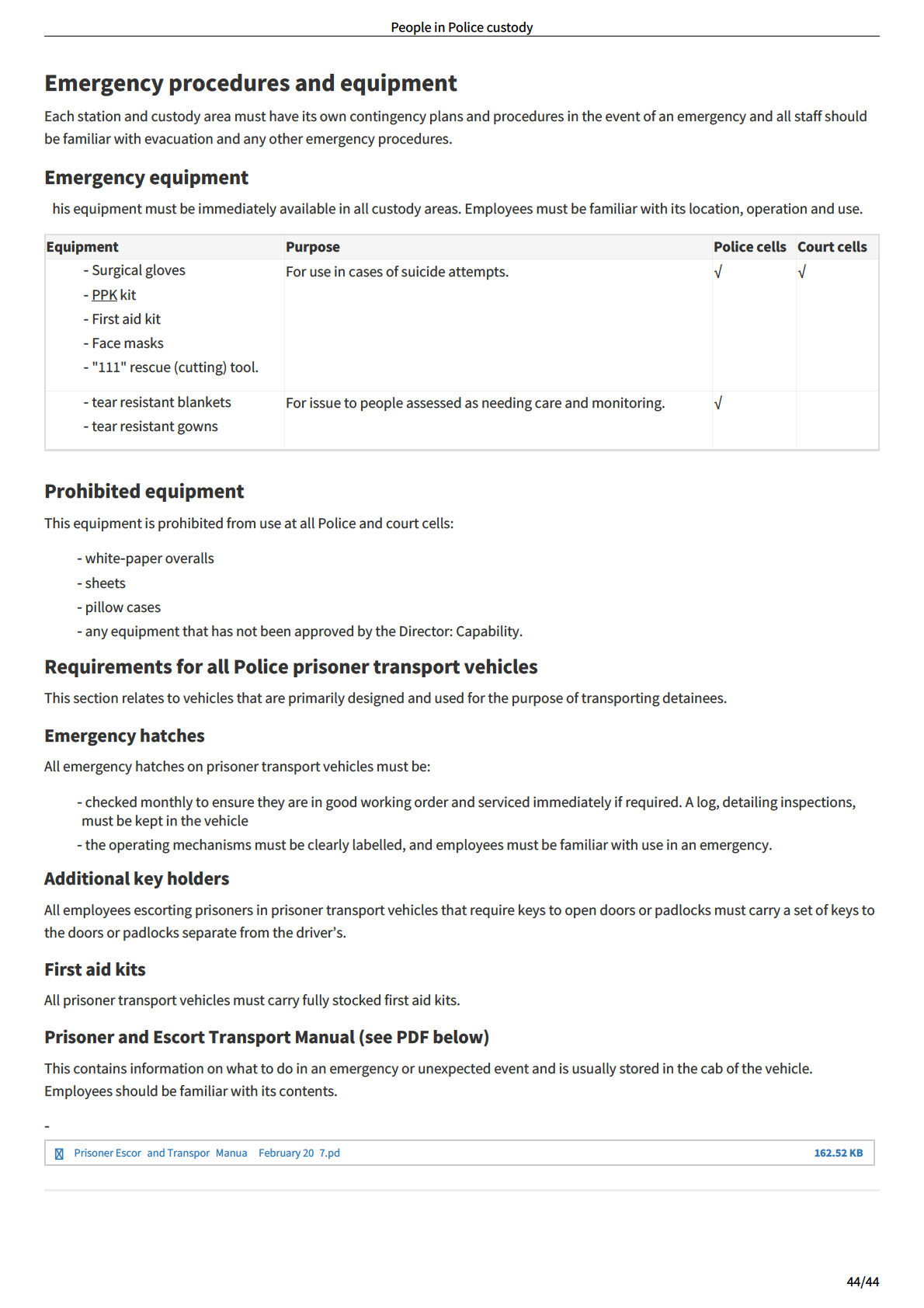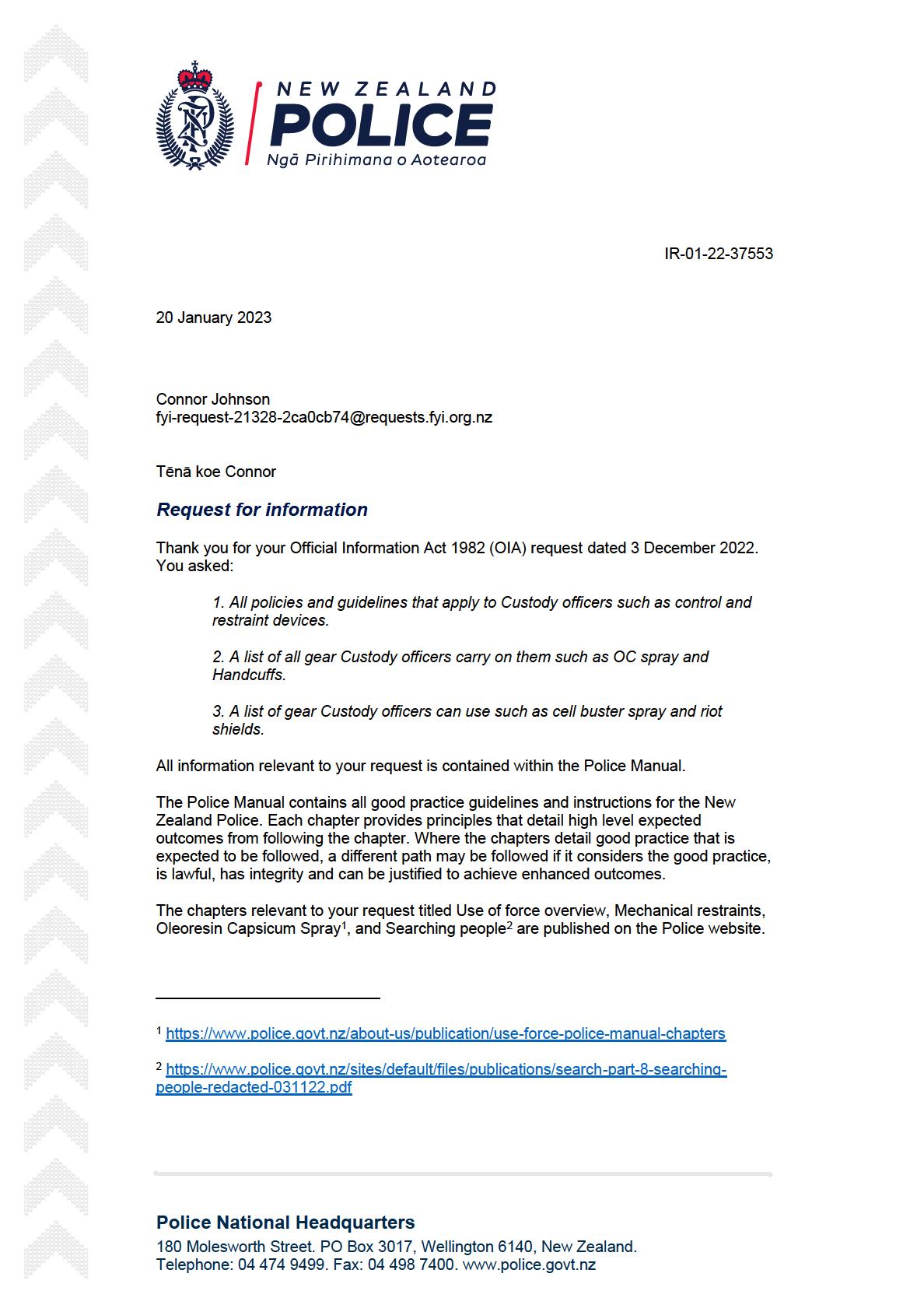
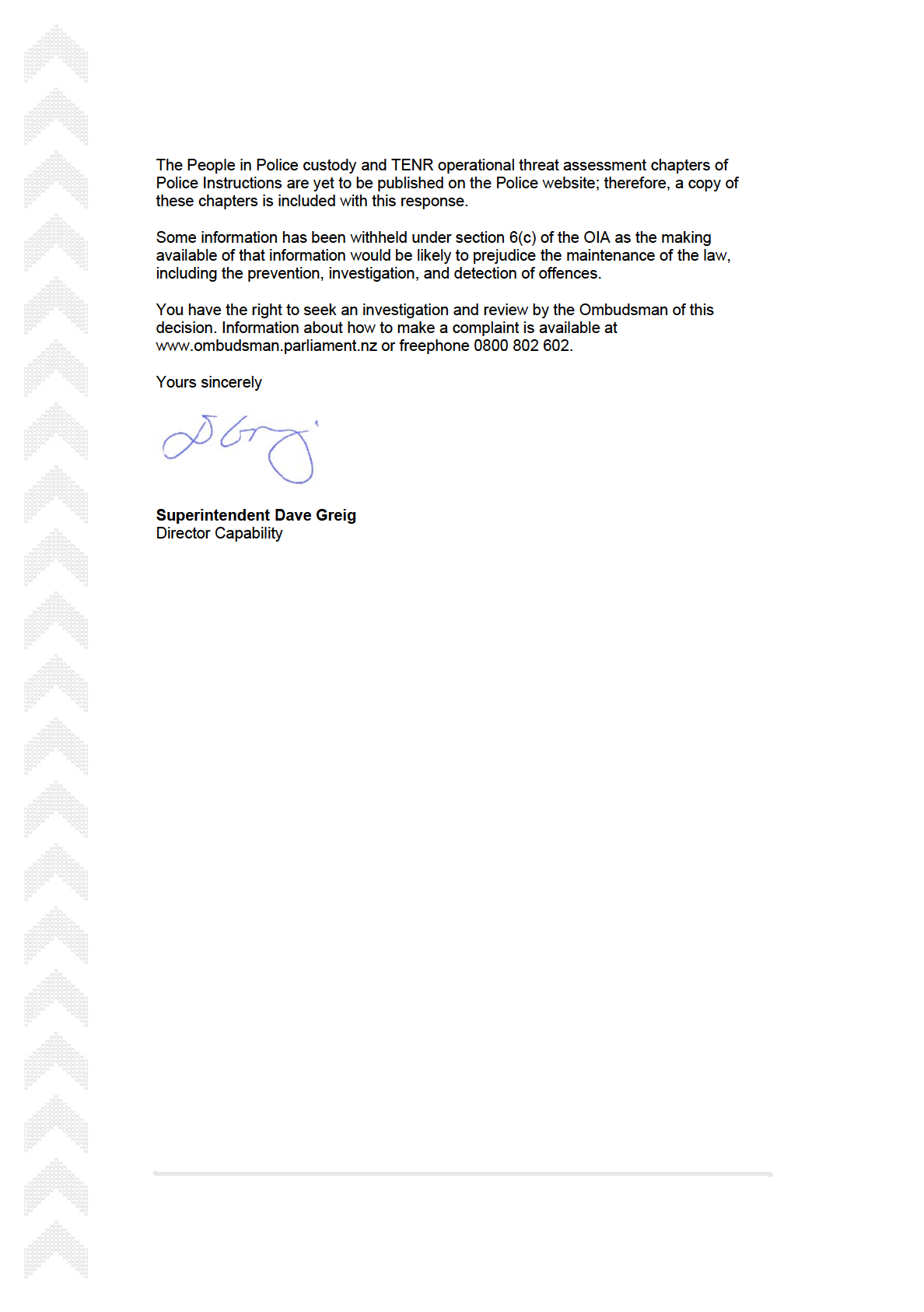
TENR-Operational threat assessment
Table of Contents
Table of Contents
2
Overview
3
Executive summary
3
Application and purpose
3
Definitions
3
TENR ‐ operational threat assessment
4
TENR elements
4
Things to be aware of
4
TENR diagram
4
Roles and responsibilities
6
Employee responsibilities
6
Supervisor responsibilities
6
Police organisational responsibilities
6
TENR assessment procedures
8
Assessing the threat
8
Assessing the exposure
9
Assessing the necessity to act now, later or not at all
10
Developing a response
11
Before you respond
11
Your response options
11
Response methods
11
Recording and reporting
12
Notebook recording
12
Reporting the use of force
12
Debrief
12
Data updates and reports (lessons learnt)
12
TENR-Operational threat assessment
Overview
Executive summary
he Police threat assessment methodology (TENR) is a decision making process that supports the timely and accurate assessment of
nformation directly relevant to the safety of Police and others. The response to any given situation must be considered, timely,
proportionate and appropriate.
he overriding principle when applying TENR is that of 'safety is success'. Victim, public and employee safety are paramount, and every
effort must be made to minimise harm and maximise safety. In addition, these critical points apply:
‑ Police must apply TENR assessment methodology to all policing situations that involve risk and have the potential to cause
harm.
‑ TENR assessments must be carried out in conjunction with the Police Integrated Tactical Training (PITT) and Use of force
chapters of the Police Manual, the
Tactical Options Framework (see PDF below), associated staff safety technical training
regimes, the Co‐ordinated Incident Management System, Civil Defence and Emergency Management and other relevant Police
Manual chapters and Standard Operating Procedures.
‑ TENR can be conducted intuitively, worked through in a Police notebook, or in detail as part of a planned operation, depending
on the circumstances.
‑
Tac ica op ions ramework (PDF)
147.26 KB
* A notebook card of the above (pdf) can be ordered via Lockheed Martin (710237 Lockheed PLC241 tac op
‐card)
Application and purpose
This chapter applies to all:
‑ constables
‑ authorised officers
‑ any other Police employees who from time to time may need to conduct a threat or risk assessment
and:
‑ details the policy behind TENR and how it must be used.
Definitions
'Threat' means any individual/s, or any act/s, or anything/s likely to cause harm or that have the potential to hinder
Threat
Police in the performance of their duties.
Exposure 'Exposure' means the potential for harm (physical or otherwise) to people, or the security of places or things. Exposure can
be mitigated through assessment and planning.
Necessity 'Necessity' is the assessment to determine if there is a need for the operation or intervention to proceed now, later or not at
all.
Response 'Response' means the proportionate and timely execution of Police duties aided by the appropriate use of tactics and
tactical options.
Risk
'Risk' means the effect of uncertainty on Police objectives combining the consequences of an event and the associated
likelihood of that event occurring.
Suspect 'Suspect' means a person who poses a threat of harm to themselves, other members of the public or Police.
3/12
TENR-Operational threat assessment
TENR ‐ operational threat assessment
TENR elements
TENR is a tool that enables better decision‐making where:
T ‐ the
threat is assessed
E ‐ the
exposure is managed
N ‐ the
necessity to intervene is considered
R ‐ and any
response is proportionate, and based on a considered risk assessment of threat, exposure and necessity.
Things to be aware of
When you apply TENR you must:
‑ comply with existing legislation and policy
‑ respond proportionately to any threat.
TENR is not an end in itself ‐ where appropriate, it guides:
‑ effective training, specifically staff safety technical management
‑ robust systems
‑ operational preparedness
‑ accurate and timely intelligence
‑ effective communication
‑ quality supervision and leadership
‑ robust command and control framework
‑ the Tactical Options Framework.
TENR diagram
4/12

TENR-Operational threat assessment
5/12
TENR-Operational threat assessment
Roles and responsibilities
Employee responsibilities
Employees must take all reasonable care for their own health and safety, and take reasonable care that their acts or omissions do not
adversely affect the health and safety of other persons. Each employee has a responsibility to identify, assess and control risks within
the workplace and in the operational policing environment.
Employees are subject to the chain of command and have an overriding responsibility to act reasonably, act in compliance with this
chapter, and act with legal justification during the execution of their duties.
Employees must ensure:
‑ their training certifications in all required competencies are current
‑ they carry their authorised equipment and appointments when they deploy on duty
‑ they are fit for duty
‑ they understand and comply with legislation, policy and procedures
‑ they follow lawful orders and instructions
‑ they report identified training, knowledge and experience gaps to their supervisor and seek guidance when necessary.
Any incident has the potential to develop and change quickly. It will not always be possible to have complete and accurate information
about the incident at hand. In these instances, employees must be able to demonstrate they followed relevant Police operating
procedures during the 'necessity' to act assessment.
Understanding the threat, exposure and necessity will guide planning leading to the 'response'. The response must be proportionate
to the threat and the risk to Police and the public. In some instances ‐ having taken all of the circumstances into account ‐ it might be
appropriate to delay an immediate response.
Employees should seek the advice and guidance of a supervisor or other more experienced officers where a developing situation
requires this support.
All employees must understand and apply TENR within the operational policing environment.
Supervisor responsibilities
Supervisors must ensure:
‑ all employees understand and apply TENR within the operational policing environment
‑ before, during and after each phase of any operation or relevant incident, the situation is assessed and reassessed
‑ employees are adequately trained, certified and equipped and the equipment is current, in working order and is available to
staff in accordance with policy, practice and procedures
‑ faults or gaps in training and experience are identified, reported and addressed and failure to meet training standards is
performance managed in accordance with the performance improvement framework
‑ risky behaviours are identified and mitigated
‑ active leadership in risk situations
‑ appropriate debriefs are undertaken with employees; ensuring that lessons learned are recorded through the Lessons Learnt
Intranet page, and information relating to new police operational procedures supported by technical developments are shared,
(subject to the appropriate mandate from Police).
Police organisational responsibilities
Police has responsibilities to provide employees with:
‑ accurate policy and procedures,
‑ training,
‑ supervision and,
‑ suitable equipment
6/12
TENR-Operational threat assessment
to most effectively manage the threats posed by the environment in which they are operating.
olice must also take reasonable steps to:
‑ acquire and keep up to date knowledge of work health and safety matters
‑ gain an understanding of the nature of the hazards and risks associated with operational policing
‑ use appropriate resources and processes to eliminate or minimise risk to health and safety from operational policing
‑ ensure appropriate processes for receiving and considering information regarding hazards and risks, and for responding in a
timely way to that information.
7/12
TENR-Operational threat assessment
TENR assessment procedures
Assessing the threat
hreat is about how serious the situation is (or could be), and the present or potential danger the situation, environment, or suspect
presents to themselves, other members of the public or Police. In relation to a suspected offence, it includes the suspect's intention to
esist or avoid arrest. Police must assess the threat posed by the suspect/situation based on all available information including what
they see and hear, and what is known about the suspect/situation.
n order to better understand the threat of a situation or suspect, the 'threat' element of TENR is broken down into the following four
sub‐sets:
‑
Intent
‑
Capability
‑
Opportunity
‑
Physical environment.
Follow these steps to assess the threat.
8/12
TENR-Operational threat assessment
Step
Assess
1
Intent
In regards to a suspected offence, consider the situation and/or the suspect's likely intent by asking yourself:
‑ What crime(s) has been committed/detected/signalled?
‑ What current offending is being investigated?
‑ Is this a continuing threat?
‑ What is the likely current state of mind (based on their actions) and mental health of the suspect?
‑ How committed is the suspect to achieve the criminal aim?
‑ Is there propensity for violence / anti‐social behaviour if confronted?
‑ Is the suspect under the influence (or likely to be under the influence) of any substances?
‑ What is the history of criminal activities and associations?
‑ What do Police know about the suspect?
2
Capability In regards to a suspected offence, consider if the suspect is physically capable of carrying out the threat by asking
yourself:
‑ Is there a history of firearm (or other weapon) possession or use?
‑ Does the suspect have knowledge of and access to counter‐surveillance, computer or other electronics
equipment?
‑ Does the suspect own or have access to motor vehicles?
‑ Has the suspect been imprisoned, involved in criminal activities and associations, or do they have knowledge of
law enforcement process or procedures?
‑ Was the suspect ever targeted by Police?
‑ Does the suspect have known co‐offenders, associates, gang affiliations/associations? Will they influence the
suspect's behaviour?
‑ Does the suspect have family, neighbours and others that can provide information or influence the suspect's
behaviour?
‑ What do Police know about the location?
3
In regards to a suspected offence, consider what means or opportunity the suspect has to carry out any unlawful
Opportunity intention or threat by asking yourself:
‑ Does the suspect have the capability or means (e.g. firearm) with which to carry out the act?
‑ Is the suspect anywhere near the intended victim?
‑ Does the location support the suspect's intent?
4
Physical
In regards to any situation, consider the physical environment Police are entering into and what risks are present within
environment that environment. These may be risks associated with a suspect, other persons in the environment, physical terrain,
weather and lighting conditions, fires, chemicals, gases or other environmental factors:
‑ Are there problems with the approach, exposure, or access to the location?
‑ Does the terrain, vegetation, obstruction, or other issues create hazards?
‑ If approaching a suspect's house, is it likely the location is fortified, secured by alarms, lights, other measures,
guarded by dogs, or are there other hazards?
‑ Has the location ever been used as a 'clan lab' or does it pose a biological/safety hazard?
‑ How far away is additional support for the suspect?
‑ Are other subjects involved, or likely to become involved, and what are their capabilities?
Assessing the exposure
Exposure is about the potential harm to Police employees, Police operations, Police reputation and to others. In all instances, good
assessment and planning can mitigate the degree of exposure.
To understand exposure better, consider exposure in the following subsets:
9/12
TENR-Operational threat assessment
‑
Safety
‑
Security.
Follow these steps to assess the exposure.
Step
Assess
1
Consider the type of injury or harm that could occur to Police employees or the public, including victims, family and passers‐
by. Ask yourself:
Safety
‑ How close are Police and others to the threat posed by the suspect or situation, and how will Police control that
threat? For example, where a suspect's capability extends to the use of firearms, Police must consider how close to the
source of that threat Police and others should be.
‑ Is there potential for force to be used against an employee or the public?
‑ Is there a likelihood of harm from any source during the intended deployment?
‑ Do Police have the appropriate resources (staff, tactical options) available to manage the threat? How far away is
additional support?
‑ Am I current in training? Do I have the right skills for this situation? Do I have current and working equipment to
protect me and others?
‑ What are the likely outcomes of the proposed Police action?
2
Consider the security of the operation which, if not properly managed, could lead to failure. Ask yourself:
Security
‑ Are your communications secured?
‑ Is there potential to lose or damage Police equipment?
‑ Can cordons be established and maintained to contain the subject(s)?
Assessing the necessity to act now, later or not at all
Any response to a situation must first take into account all available information and must be supported by a clear assessment of the
known threat and exposure involved.
Follow this step to assess 'necessity' ‐ whether to act now, later or not at all ‐ so that you come to an informed decision of how critical
it is to respond.
StepAssess
1
Every Police deployment must be timely and proportionate to the threat and the exposure. Ask yourself:
‑ Is it appropriate to delay the response?
‑ Have you identified the suspect?
‑ Do you have processes and controls available to de‐escalate the threat to a manageable level?
‑ Are you trained and skilled to meet the threat?
‑ Do you have all the resources you need to respond safely and effectively now or, should I delay the response until the
right resources are available?
‑ Is there a clear chain of command?
‑ What are the consequences to Police and/or public in delaying the response?
Important: Any option must reasonably endeavour to
maximise safety and
minimise risk.
10/12
TENR-Operational threat assessment
Developing a response
Before you respond
Discuss your intended response with your supervisor where the necessity to respond permits.
Your response options
Consider the options available to you based on threat, exposure and necessity, and plan a response that is timely, proportionate and
appropriate. Ask yourself:
‑ Should you delay action until other resources, skills or equipment are available? Remember that caution is not cowardice, and
there may be good reasons to cordon and contain the subject while awaiting the arrival of specialists ‐ e.g. AOS, PNT.
‑ Is a more detailed investigation into the threat environment required before you can act safely?
‑ Do you need to take prompt action to prevent further loss of life or injury? Remember that even in active situations you must
first carefully assess the situation and make decisions, based on appropriate and approved risk assessment methods, and
supported by your training and experience.
Note: Remember that in active response situations you must continuously reassess your response based on the situation as it unfolds,
and the subject's behaviour.
Response methods
Any action you take in response to a suspect/situation related threat must be in accordance with the Police Integrated Tactical
raining (PITT) and Use of force chapters of the Police Manual, the
Tactical Options Framework (see PDF below), associated staff
safety technical training regimes, the Co‐ordinated Incident Management System, Civil Defence and Emergency Management and
other relevant Police Manual chapters and Standard Operating Procedures.
‑
Tac ica op ions ramework (PDF)
147.26 KB
11/12
TENR-Operational threat assessment
Recording and reporting
While recording and reporting is not part of the operational TENR threat assessment process, these are things you need to consider:
Notebook recording
You should make use of your notebook in unplanned incidents, if time allows, to record your TENR threat assessment ‐ see notebook
guidelines in the 'Notebooks and Job Sheets' chapter.
Reporting the use of force
Use of force must be reported in a Tactical Options Reporting (TOR) form, according to the reporting instructions in the 'Use of force'
chapter.
Debrief
You should conduct or be part of a formal or informal debrief ‐ see 'Debriefs' chapter.
Data updates and reports (lessons learnt)
You should provide data updates or reports as required by the 'Debriefs' chapter. Lessons learned should be submitted via the Lessons
Learnt Intranet site.
12/12
People in Police custody
Table of Contents
Table of Contents
2
Policy statement and principles
5
What
5
Why
5
How
5
Overview
6
Introduction
6
Purpose of this chapter
6
General duty of care
6
Health and Safety at Work Act 2015
6
Consultation with IPCA
7
Who do these instructions apply to?
7
Definitions
7
CA team
7
CMC
7
Custody Area
7
Deta nee
7
DAO
7
Eva uat on
7
ECM
7
Hea th profess ona
7
Related information
7
Taser and firearm not to be taken into custodial areas
9
Procedures
10
Procedures for officers who arrest or detain
10
Non‐Police arrests
11
Procedures for custody area staff
12
Additional procedures for certain types of detainees
14
Detainees who are dangerous
16
Detainees affected by drugs/alcohol or medical complications
17
If the person is ..
17
Intoxication can mask medical conditions
17
Case stud es deaths n Po ce custody
17
Methy ated sp r ts
17
Detention for mental health assessment
18
Detainees with responsibility for children or young persons
19
Detainees with breastfeeding responsibilities
19
Procedures for receipt and assessment at court cellblocks
20
Receiving people waiting for court documentation completion
20
Management of youth detainees at court
20
Detainee's property
21
Receiving and recording detainees property
21
Storage of detainee property photographs
21
Examples of detainee property photographs
22
Releasing property during custody
22
Returning property on detainee's release
23
Transferring property
23
Placement in cells
25
Segregation of certain types of detainees
25
You must segregate…
25
f pract ca separate…
25
Procedure for placing detainees in cells
25
Monitoring and checking detainees
26
Types of checks
26
Obse vat on check
26
Verba check
26
Phys ca check
26
Monitoring levels and frequency of checks
26
f the deta nee requ res…
26
Monitoring requirements when in restraints
26
Wh e restra ned by one or more of the fo ow ng a deta nee requ res care and frequent mon tor ng
26
Wh e restra ned by one or more of the fo ow ng a deta nee requ res care and constant mon tor ng
26
Responsibilities and procedures for monitoring
27
Custody staff
27
Person n charge of ce b ock
27
Hea th profess ona
27
Use of CCTV for monitoring movements in custody areas
27
Detainees' rights in custody
29
Solicitors
29
Foreign nationals
29
Visitors and phone calls
29
V s ts
29
Manag ng v s ts
29
Phone ca s
30
Phone enqu r es about deta nees
30
Complaints
30
IPCA monitoring of Police places of detention
30
Meals and hygiene
32
Cleaning
32
Hygiene
32
Smoking
32
Meals
32
Drink
32
Transferring / transporting detainees
33
Transporting to court, prison, or another place
33
Carry out a TENR risk assessment
33
hreat
33
E Exposure
34
N Necess ty
34
R Response
34
When a ternat ve prov ders are used
34
Additional risk factors for Department of Corrections prisoners
34
Who is to accompany a detainee on transfer?
34
Ensure the detainee has been properly searched
34
Ensure the following documents and items are transferred with the detainee
35
Before beginning your transport
35
During transport
35
Transporting detainees to a medical facility
36
Prisoner Escort and Transport Manual
37
Releasing detainees
38
Every release
38
Releasing unlawfully detained people
38
Releasing without charge
38
Releasing temporarily for interviews
39
Releasing with a formal warning
39
Releasing on summons
39
Releasing on Police bail
39
Suicide attempts and deaths in custody
41
Responsibility to prevent suicide
41
Procedure when suicide attempt discovered
41
Deaths in custody
41
Offences
43
Emergency procedures and equipment
44
Emergency equipment
44
Prohibited equipment
44
Requirements for all Police prisoner transport vehicles
44
Emergency hatches
44
Add t ona key ho ders
44
F rst a d k ts
44
Pr soner and Escort ransport Manua (see PDF be ow)
44
People in Police custody
Policy statement and principles
What
‑ Police employees are responsible for the safety of themselves and others. This includes being responsible for the care and
security of people detained at scenes, during transport, within Police stations, and may include cells at courts.
‑ Police responsibility for care, safety and security starts from the moment a person is arrested or detained and does not end until
they are released or transferred into the care of another agency, individual or family member.
‑ Alongside the use of force, the detention of people is the strongest legislative power that can be executed by Police.
Why
‑ Under the Health and Safety at Work Act 2015 (HSWA), NZ Police have a primary duty of care of its workers and others affected
by our work. This includes people in Police custody as well as other people who enter the custody area (such as external
agencies etc.). Failure to comply with the People in Police Custody Policy may result in Police employees being subject to
enforcement under the HSWA.
‑ If the detainee is aged under 18, the parent, guardian or other caregiver must be informed of their arrest, regardless of their
wishes, as soon as practicable.
‑ Statutory limitations apply to the time children and young people can be detained in Police custody.
‑ Bail detainees awaiting the completion of court documentation must be bailed within two hours or obtain a warrant for their
continued detention.
‑ If a prisoner is to remain in a tear resistant gown, body shield coveralls, in handcuffs, under armed guard or in other unusual
circumstances for a court appearance, Police must ensure that they have sought the presiding Judge’s consent before the
appearance.
‑ Photograph and secure detainee’s property in a tamperproof evidence bag and seal it.
How
‑ Before transport, search detainees under section 85 or 88 of the Search and Surveillance Act where practicable to prevent them
from disposing of evidence or harming themselves or others. Leave searches under section 11 (a search of a person who is or is
about to be ‘locked up’) for completion at the station, as there are limited opportunities to search a detainee again under this
provision.
‑ Call a health professional for advice if the detainee has been injured, or you think it necessary, or the detainee requests on
reasonable grounds to be seen by a doctor.
‑ Use TENR to assess the safety and security risk, including whether it is appropriate to use mechanical restraints.
‑ Be aware of the segregation requirements for certain types of detainees.
‑ Always consider the detainee’s level of consciousness. Immediate hospitalisation is required if they are unresponsive ‐ this is a
medical emergency. Detainees who are only partially responsive, should also be taken to hospital.
‑ Record any risk information, all special care instructions, and everything that happens in relation to a detainee, from processing
to release, in the ECM.
5/44
People in Police custody
Overview
Introduction
olice employees are responsible for the safety of themselves and others, and also the care and security of everyone detained
ncluding at scenes, during transport, within Police stations and cells at courts.
olice responsibility for care, safety and security starts from the moment a person is arrested or detained and does not end until they
are released or transferred into the care of another agency, individual or family member.
Alongside the use of force, the detention of people is the strongest legislative power that can be executed by Police. To ensure every
detainee is treated humanely we will:
‑ comply with all legislation related to detained people
‑ ensure all staff working in custody areas understand and apply the contents of this chapter
‑ ensure sufficient staff are allocated to work in custody areas
‑ ensure appropriately trained staff are allocated to work in custody areas.
Purpose of this chapter
This chapter details from the time of arrest or detention:
‑
procedures for the receipt, assessment, monitoring and management of people in Police custody, especially when:
‑ alcohol or drugs have been consumed
‑ the person has been injured or has a known medical problem
‑ there is a perceived suicide risk or risk of the person harming themselves
‑ the
responsibilities and duties of employees involved operationally in custodial management, for the health, safety and
secure custody of all people held by them.
In particular, the chapter aims at:
‑ ensuring appropriate care is provided for detainees with physical or mental health needs
‑ preventing harm, self‐harm, suicide and attempted suicide during or post detention
‑ providing a safe and healthy work environment
‑ using TENR assessments to assist in maintaining the safety and security of detainees and others.
General duty of care
Where a Police employee has care or charge of a person in detention (or who believes they are unable to leave), the Police employee is
under a legal duty of care to provide that person with necessities and to take reasonable steps to protect that person from injury
(including self‐harm or harm from others).
This duty starts from the moment of arrest and continues until care of the person is transferred to someone else or the person is
released.
This policy, and other relevant Police policies and procedures, details the steps Police employees must take to meet this duty of care.
Failure to exercise your duty of care could result in charges or disciplinary action under the code of conduct for misconduct.
Health and Safety at Work Act 2015
Under the Health and Safety at Work Act 2015 (HSWA), Police have a primary duty of care to ensure, so far as reasonably practicable,
the health and safety of its workers and others affected by our work. This includes a duty to ensure the health and safety of people in
Police custody as well as other people who enter the custody area (such as external agencies etc.).
Police Officers, Authorised Officers, and all other Police staff (including Senior leadership teams) working in or influencing the
operation of Police custody also have duties under HSWA. HSWA duties also extend to contractors and other workers who do not work
for NZ Police but work within custody units such as DAOs and nurses. Under HSWA, individuals have a duty to:
‑ take reasonable care for your own safety
6/44
People in Police custody
‑ take reasonable care that your acts or omissions do not adversely affect the health and safety of other persons (including
detainees)
‑ comply with any reasonable instruction given by NZ Police in order to ensure compliance under the HSWA
‑ cooperate with any reasonable policy or procedure of NZ Police relating to health or safety at the workplace (for example ‐ the
People in Police Custody policy).
Failure to comply with the People in Police Custody Policy may result in Police workers being subject to enforcement under HSWA.
This includes the potential for prosecution and/or a fine. Further information on duties and offences can be found in Part 2, subpart 4
of HSWA.
Consultation with IPCA
This chapter has been written in consultation with the Independent Police Conduct Authority (IPCA) which is responsible for the
inspection and monitoring of Police detention facilities and the treatment of detainees under the UN Optional Protocol to the
Convention Against Torture (OPCAT). The chapter incorporates the Protocol’s requirements for the management of persons in
custody. For more information on the IPCA’s role under the protocol see ‘IPCA monitoring of Police places of detention’ in this chapter.
Who do these instructions apply to?
These instructions must be applied to any person detained by Police under any enactment, whether or not they have been arrested.
Definitions
See the meaning of terms used in this chapter below.
CAT team
Crisis Assessment Team (CAT). Health professionals who assess those with a potential mental disorder and arrange appropriate care.
CMC
Custody Management Console (CMC) displays information on detainees in custody at a given time. The CMC allows the management of
multiple detainees at once.
Custody Area
A dedicated area for receiving, processing and holding detainees, temporary and permanent.
Detainee
Anyone who is arrested or detained under any enactment, or any person who reasonably believes they are not free to leave.
DAO
Duly Authorised Officer (DAO) A designated and authorised health professional who has appropriate competence in dealing with
persons who are mentally disordered in accordance with the Mental Health (Compulsory Assessment and Treatment) Act 1992.
Evaluation
The recording of behavioural, mental and physical health indicators in the ECM or on the charge sheet for the purpose of establishing
the level of care and monitoring required.
ECM
NIA electronic custody module (ECM) holds all information that is pertinent to the detainee.
Health professional
Medical practitioner or mental health professional, duly authorised officer, nurse, or Crisis Assessment Team member.
Related information
This chapter must be read in conjunction with these Police Manual chapters:
7/44
People in Police custody
‑ Managing prisoners on behalf of Corrections
‑ Searching people
‑ Youth Justice (for information about holding children and young persons in custody)
‑ TENR ‐Operational Threat Assessment
‑ Use of force
‑ Mechanical restraints
‑ Positional asphyxia
‑ New Zealand Bill of Rights.
8/44
People in Police custody
Section 6(c) Official Information Act 1982
9/44
People in Police custody
Procedures
Procedures for officers who arrest or detain
he arresting or detaining officer is responsible for safety and security, especially the detainee’s, until they are handed over to custody
area staff. This topic outlines procedures that must be followed from the time of arrest or detention to ensure those responsibilities
are met.
StepAction
1
Carry out an initial assessment of risk in regards to the detainee at the time of arrest or detention.
The responsibility of the arresting officer remains until the detainee is formally processed and evaluated in the ECM, unless
responsibility is transferred to another officer, agency or person.
2
Carry out a rub‐down search of the detainee under section 85 or 88 of the Search and Surveillance Act 2012 (S&S Act)
before
transport, and remove articles that:
‑ may be used to:
‑ harm the detainee or anyone else, or
‑ assist their escape, or
‑ cause damage (e.g., to the vehicle), and
‑ under s88,
if you have reasonable grounds to believe the person has on them or is carrying evidential material relating
to the offence for which they are arrested or detained, you may also remove that evidential material.
Ensure that there is another employee present where possible.
Notes:
‑ If it is not practicable to search detainees immediately after they are taken into custody, take care to prevent them from
disposing of evidence or harming themselves or others.
‑ Leave searches under section 11 of the Act (a search of a person who is or is about to be ‘locked up’) for completion at the
station (Step 7 below). If s11 is used for the search before the person is at a Police station, they can only be searched again
if one of the circumstances in s11(3) of the Act apply.
‑ For more information, see ‘Searches of arrested or detained people’ in the ‘Searching people’ chapter.
3
All detainees must be considered to be ‘at risk’ until an evaluation takes place.
‑ Those without signs of suicide risk must be frequently monitored.
‑ Those with signs of suicide risk must be constantly monitored.
Note: It is sufficient to comply with this step if the detainee is under the direct supervision of a third party, e.g., a doctor treating
an injured detainee, or a lawyer speaking to the detainee in an interview room.
4
Ensure a NIA check is done at the earliest opportunity. Be vigilant for any flags relevant to the detainee’s safe custody or risk
including previous alerts and evaluation history records and advise the employee receiving the detainee of these.
Note: “Evaluation History” can be accessed by query person and opening the last custody record for the detainee (Records,
select “Custody” category and open Evaluation History).
5
Transport the detainee after an assessment of risk using TENR. Consider the use of mechanical restraints. When transporting
apply the segregation requirements.
10/44
People in Police custody
6
When detainees are formally received at the custody area, advise the employee receiving them of:
‑ the reason for the detention
‑ whether the person can be bailed or released
‑ any special care required.
Ensure that risk information and any special care instructions are recorded in the ECM.
7
Search the detainee under section 11 of the Search and Surveillance Act 2012, preferably in the presence of the custody staff.
Note: Once a detainee has been searched at a Police station and is, or is to be, “locked up”, they can only be searched again if
one of the circumstances in section 11(3) of the Search and Surveillance Act 2012 apply. See ‘Searches of arrested or detained
people’ in the ‘Searching people’ chapter.
8
Advise the detainee of their rights in custody by asking them to read and sign the ‘Notice to Person in Custody’ form. Witness
their signature and file the signed form. (If they refuse to sign, note this on the form.)
If the detainee is unable to read the notice, read it to them and ensure they understand it. (Notices are available in a number of
different languages ‐ see Police Intranet> Response and Operations> Legislation and Resources, or if necessary, an interpreter
could be engaged). Endorse the back of the form to indicate the action taken.
9
Help the custody staff place the detainee safely in a cell.
Non‐Police arrests
If a person is brought to a station to be held in custody following their lawful arrest by someone other than a constable:
‑ the person making the arrest must sign all documentation relating to the actual arrest
‑ a constable or authorised officer must then carry out all other procedures.
11/44
People in Police custody
Procedures for custody area staff
Everything that happens in relation to a detainee, from processing to release, must be recorded in the ECM or the Inspection of
Prisoner book if the ECM is not available.
You must follow these steps in relation to all detainees in Police custody.
StepAction
1
Inform the custody supervisor when a detainee is about to be received.
2
Enter the detainee’s details and complete the evaluation in the ECM as soon as practicable.
3
Verify the arresting officer’s search under section 11 of the Search and Surveillance Act 2012. See step 7 of the procedures for
officers who arrest or detain.
4
Follow the procedures for receiving detainees’ property in this chapter.
5
If the detainee has had clothing seized by Police, issue them with:
‑ appropriately sized blue disposable “Body Shield” polypropylene coveralls, or
‑ other appropriate clothing.
6
‑ For detainees identified as a suicide risk consider removing their clothing and replacing it with a tear resistant gown.
Section 6(c) Official Information Act 1982
12/44
People in Police custody
Section 6(c) Official Information Act 1982
8
Ensure that risk information and any special care instructions are recorded in the ECM. If the detainee is deaf or has hearing
difficulties to an extent that may impact on their ongoing care, ensure this is recorded in the ECM. Refer to the Interpreting for
the deaf chapter if an interpreter is required.
9
Evaluate and classify the detainee into one of the following categories:
‑ Not in need of specific care
‑ Care and frequent monitoring
‑ Care and constant monitoring)
(See monitoring levels in this chapter for more information).
Constant or frequent monitoring is mandatory for detainees:
‑ in certain types of mechanical restraints
‑ at risk of suicide.
Until the evaluation takes place all detainees must be considered to be ‘at risk’ and frequently monitored, with the exception of
detainees showing signs of suicide risk ‐ they must be constantly monitored. If the detainee is unable to be evaluated for any
reason, then this monitoring regime remains until the evaluation is completed in its entirety.
Note: As part of the Evaluation process in the ECM it is necessary to check alerts and “Evaluation History” and record in the
current evaluation any relevant risk.
13/44
People in Police custody
10 Call a health professional (use Police medical officers where practical) for advice / assistance if:
‑ the detainee has been injured (especially where a potential head injury has occurred proximate to the detention)
‑ you are supervising a detainee and think it necessary, or
‑ a detainee, on reasonable grounds, requests to be seen by a doctor.
If a medical examination is undertaken, ensure a copy of the medical report is filed and a copy is provided with the detainee on
transfer. If any other advice is received from a health professional, ensure this is recorded in the ECM.
In all cases always consider the level of consciousness and whether the person should be transferred to a Health facility. See
dealing with ‘Detainees affected by drugs/alcohol or medical complications’.
11
Medication
‑ Check if the detainee has any prescribed medication.
‑ Allow the detainee to take the medication in accordance with the prescription information so long as the prescribed
medication is in the name of the detainee and a visual examination of the medicine does not raise concerns about its
legitimacy
Note: injectable medications (e.g. insulin) for suicidal detainees must only be administered in the presence of,
or by, a health professional.
‑ If the medication is not held with the detainee, it may need to be obtained from the detainee’s home or through a new
prescription.
‑ Record the details of the medication, including the dosage and timing, in the ECM.
‑ Call a health professional where you are concerned that the medication may not be legitimate.
12 Check the appropriate ‘Notice to Person in Custody’ (POL 48H):
‑ was read to or by the detainee
‑ either signed by the detainee or, if they refuse to sign, endorsed by the arresting/detaining officer
‑ is filed with other custody documents.
13
Notification
‑ With the permission of the detainee, Police may notify a person of the detainee’s choice that they have been detained
and whether they can be released.
‑ If the detainee is aged under 18, the parent, guardian or other caregiver
must be informed of their arrest, regardless of
their wishes, as soon as practicable (s8 Oranga Tamariki Act 1989)
When the notification has been completed, update the ECM.
14 Obtain appropriate biometric data from the detainee as applicable (s32 or 33 Policing Act 2008 and Criminal Investigations
(Bodily Samples) Act 1995).
15 Complete remaining fields within the ECM. Check all the information is correct and complete.
16 Identify a suitable cell and place the detainee in the cell. Maintain segregation.
17 Maintain the monitoring/checks as per their evaluation. Remember that a person's status may change requiring a re‐evaluation.
(For more information on when re‐evaluation of a person’s risk may be required, see ‘Responsibilities and procedures for
monitoring’).
18 Note that there are statutory limitations on the time that children and young people can be detained in Police custody. For more
information, see ‘Charging and holding children and young persons in custody’ in the ‘Youth Justice’ chapter.
Additional procedures for certain types of detainees
See also these topics for additional procedures / considerations relating to certain types of detainees:
‑ Detainees who are dangerous
14/44
People in Police custody
‑ Detainees affected by drugs/alcohol or medical complications
‑ Detention for mental health assessment
‑ Detainees with responsibility for the care of children or young persons
15/44
People in Police custody
Detainees who are dangerous
ollow these steps:
StepAction
1
Use TENR to assess the safety and security risk, including whether it is appropriate to use mechanical restraints.
2
Continue to use TENR to re‐assess the risk during detention and transfer. The transfer to court may need to be delayed and the
case adjourned if the detainee cannot safely be put before the court.
3
The custody supervisor should be present when processing dangerous detainees.
4
Only use reasonable force to secure the detainee if required.
5
Search the detainee while restrained.
6
Segregate the detainee from others.
7
Monitor and re‐assess the detainee’s health regularly. Dangerous detainees may become suicidal or unwell due to drug or
alcohol consumption as their detention continues. Be mindful of the risks of excited delirium and positional asphyxia.
8
Inform the on‐coming shift about concerns relating to the detainee and what action has been taken. Record the handover in
ECM.
16/44
People in Police custody
Detainees affected by drugs/alcohol or medical complications
If the person is ...
‑
Alert ‐ able to engage in a coherent conversation ..
THEN ‐ follow the procedures for custody area staff.
‑
Voice / Drowsy or confused ‐ responds to voice and able to reply. May need some assistance to walk ..
THEN ‐ follow the
procedures for custody area staff. Be aware that the level of consciousness may change over time due to intoxication or medical
complications.
‑
Pain / Partially responsive ‐ responds to pain only (e.g. nail‐bed pressure) ..
THEN ‐ treat this as a medical emergency and
arrange for the person to be taken to hospital.
‑
Unresponsive ‐ does not respond to any stimuli ..
THEN ‐ this is a medical emergency and immediate hospitalisation is
required. If you expect a delay in the ambulance's arrival or the person's condition calls for immediate action, use a Police
vehicle.
Note: If the person is detained for detoxification (s36 Policing Act 2008), consider the requirements of the Act to take the person to
their place of residence. This option is not available for partially or unresponsive detainees.
Intoxication can mask medical conditions
Intoxication can mask underlying medical conditions which can go undetected when custody personnel assume the person just needs
to ‘sober up’.
Note: Loud snoring is a sign the person is deeply unconscious.
Case studies ‐ deaths in Police custody
Prisoner A was located by Police on a suburban street having fallen onto his back. He was transported and then carried into the Police
station where he was placed into a cell to sober up. Unbeknown to Police the heavily intoxicated male had struck the back of his head
and suffered a brain bleed. The head injury was not readily apparent. During the night the prisoner was noted to be snoring loudly
however staff neither checked nor attempted to waken him. The person subsequently died from the unnoticed head injury.
Prisoner B was an alcoholic who lived on the streets. He was detained for detox. On being received into the custody area, he was
coherent and told Police he suffered from epilepsy but hadn’t been taking his medication. He was placed into a cell to sober up but a
few hours later suffered a grand mal epileptic seizure and died. Medical advice is that those suffering from epilepsy are at a higher risk
of having a fit when they do not take their medication and are sobering up.
Police employees need to be aware of the masking effects of intoxication regarding any medical condition and the risk posed by the
mixture of alcohol, drugs and current or pre‐existing medical issues.
Methylated spirits
A person who has been drinking methylated spirits will sober up more quickly than a person who has been drinking alcohol ‐ usually,
within an hour of being detained. However, they will be in greater danger of having serious medical problems. Therefore, you must
seek medical advice before releasing the person.
17/44
People in Police custody
Detention for mental health assessment
hese steps apply when a person is detained by Police under the Mental Health (Compulsory Assessment and Treatment) Act 1992. For
more information see the 'People with mental impairments' chapter.
StepAction
1
Mental health assessments should wherever practical be carried out in the least restrictive environment. The preferred option is
the person’s home or a health facility. The custody area should only be used after all other options have been explored.
If a person is taken to a Police station they must be entered in the ECM.
2
Where possible, after considering safety, the detainee should be able to be accompanied or visited by a support person, e.g.,
friend or family member.
3
The maximum period of detention under the Act is 6 hours from the time of initial detention at the scene. They must have the
mental health assessment by a medical practitioner within the 6 hours; it is not sufficient for the detainee to be examined only by
a DAO within this time.
4
If someone is detained under s109 and is under the influence of alcohol they must still be assessed by medical practitioner
within 6 hours. Detoxification powers (s36 Policing Act 2008) do not override the detention time limit for the mental health
assessment to be carried out.
5
If the person is being detained at a Police station and it is anticipated that the assessment will not be carried out within the 6‐
hour timeframe, deliver the detainee to a hospital or other appropriate place within this timeframe and release them. This may
include the person’s home or transferring them to the care of a family member.
6
If action in step 5 cannot be facilitated, the person must be released.
Note: that a person may remain voluntarily at the Police station and outside the custody area while awaiting collection.
7
When releasing the detainee ensure that attempts have been made to get them to a place of safety, e.g. their home or into the
care of friends or family.
18/44
People in Police custody
Detainees with responsibility for children or young persons
olice who arrest or detain a person with a child in their care must ensure the safety and best interests of the child. Follow these steps:
StepAction
1
When processing detainees who are responsible for the care of children and young persons, consider:
‑ whether it is necessary for the detainee to be retained in custody or if they could be immediately bailed or released on
summons, and
‑ if it is in the best interests of the child to stay with the detained person.
2
If neither of these is an appropriate course of action:
‑ try to place the child with a member of their family, whänau, iwi or other responsible adult with the consent of the child’s
parent/guardian
‑ record the consent within the ECM or your notebook.
If no consent is given and a suitable person cannot be found to care for the child, contact the on‐duty social worker and seek a
placement with Oranga Tamariki.
Detainees with breastfeeding responsibilities
Consultation should occur with the detainee regarding the child’s feeding needs and arrangements made to accommodate them.
19/44
People in Police custody
Procedures for receipt and assessment at court cellblocks
Receiving people waiting for court documentation completion
Wherever practicable and in the absence of any reason to do otherwise, defendants bailed by the court should be directed to await bail
documentation in a suitable bail waiting area rather than the court cells.
Where people are detained for less than two hours in court cells to await bail documentation, the normal custodial procedure can be
shortened, as per the steps below.
Complete the following procedures when a person previously at large is received in a court cellblock waiting for any court bail
documentation to be completed.
StepAction
1
Everything that happens in relation to a detainee, from processing to release, must be recorded in the ECM or the Inspection of
Prisoner book if the ECM is not available.
2
Keep the detainee separated from detainees remaining or already in custody awaiting transfer to a custodial or health facility.
3
Search the detainee under section 11 Search and Surveillance Act 2012.
4
Complete an informal evaluation conversation and record the fact and any significant remarks in notebook, or charge sheet, or in
the ECM.
5
Bail the detainee within two hours or obtain a warrant for their continued detention (s31 Bail Act 2000).
6
If any property is taken, record it as per the detainee’s property section, or on the charge sheet. Return property on release
following the signing of the bail bond.
Management of youth detainees at court
he supervision and management of youth detainees who arrive at court in the custody of Oranga Tamariki remain the responsibility
of that agency. Police should not accept responsibility for the supervision and management of youth detainees in court cells.
he exception is where they are remanded into Police custody or are subject to section 242 or if their behaviour in court is such that
olice are required to invoke other powers to deal with the situation appropriately (i.e. arrest). In any situation where multiple
agencies may use the same custodial facilities, each agency remains responsible for the detainees in their custody only.
20/44
People in Police custody
Detainee's property
Section 6(c) Official Information Act 1982
21/44
People in Police custody
Section 6(c) Official Information Act 1982
Releasing property during custody
Follow these steps:
22/44
People in Police custody
StepAction
1
Obtain the detainee’s authority in writing to release the property.
2
For cash, other than small amounts, also gain authority to release it from the officer in charge of the case.
3
Update the chain of custody in the PROP system to record any movement of property.
4
Print a Property Receipt and provide to the relevant party to sign.
5
Retain the original tamper proof bag and seal it and all remaining property into a new tamper proof bag and return to the
allocated storage place.
6
Scan and attach a copy of the detainee’s written authority and the signed Property Receipt to the Property Record.
7
Retain the hard copies in accordance with current practices.
Note: Any time a sealed tamper proof bag is opened, the reasons why
must be recorded in the custody record.
Returning property on detainee's release
Follow these steps:
Step Action
1
Check the allocated storage location and the name on the property bag to ensure the correct property is being returned.
2
If the tamper proof bag has been opened, inform the custody supervisor immediately.
3
Return all property belonging to the detainee except any that:
‑ may need to be given in evidence in proceedings arising from a charge brought against the detainee
‑ may be required for further investigation, or
‑ it is an offence to possess (s13 Search and Surveillance Act 2012).
For cash, other than small amounts, gain authority to release it from the officer in charge of the case.
4
Get the detainee to endorse the receipt of their property by signing the Property Seizure and Return Form.
5
Update the chain of custody in the PROP system to reflect how the property item(s) have been disposed of.
6
Scan and attach a copy of the signed Property and Seizure Return Form to the Property Record.
7
Retain the hard copies in accordance with current practices.
Transferring property
Follow these steps when transferring property with the detainee to a prison, or another Police station or custodial facility.
23/44
People in Police custody
StepAction
1
Update the chain of custody in the PROP system to reflect how the property item(s) are being disposed of.
2
Print two copies of the Property Transfer Sheet to provide to the relevant party to sign.
3
Send the sealed property, along with two copies of the Property Transfer Sheet, with the detainee. Hand the sealed tamper proof
bag to the person now responsible for the detainee.
4
The person receiving the detainee and property:
‑ signs one copy of the Property Transfer Sheet to acknowledge receipt
‑ receives the sealed tamper proof bag
‑ returns the signed copy to the employee handing over the property who returns it to the station of origin.
5
Scan and attach a copy of the signed Property Transfer Sheet to the Property Record.
6
Retain the hard copies in accordance with current practices.
24/44
People in Police custody
Placement in cells
Segregation of certain types of detainees
his topic lists types of detainees who:
‑ must be segregated at all times from other detainees
‑ should be segregated if practicable.
You must segregate…
‑ any detainee ..
from other detainees who represent an immediate threat to them
‑ victims and/or witnesses ..
from detainees
‑ children 13 years and under ..
from young persons (14‐17) and adult detainees
‑ children and young persons (17 years and under) ..
from adult detainees
‑ 18‐year‐old Corrections' detainees ..
from other detainees
‑ female detainees ..
from male detainees
‑ transgender detainees, where identified or made known ..
from detainees whose gender they do not identify with
‑ people who have been arrested for sexual offences against children ..
from other detainees
‑ detainees with infectious diseases ..
from other detainees
‑ detainees in mechanical restraints ..
from unrestrained detainees
‑ detainees with an intellectual disability or psychiatric disorder ..
from other detainees
‑ violent detainees ..
from other detainees.
If practical, separate…
‑ detainees who have committed minor offences ..
from detainees who have committed serious crimes
‑ 18‐year‐olds ..
from detainees 19 years and older
‑ arrested detainees ..
from those who have been remanded and sentenced
‑ gang members ..
from opposing gang members.
Procedure for placing detainees in cells
Follow these steps:
StepAction
1
Decide what cell to place the detainee in by considering whether they:
‑ need to be separated from other detainees (see criteria above)
‑ are at risk from themselves or at risk from others.
2
Placing more than one detainee in a cell (double bunking) is a viable option for detainee placement. Double bunking must only
occur after a risk assessment has been completed (TENR) and the detainee’s preference has been considered.
Detainee segregation must be maintained.
3
For your own safety, always advise another employee (if possible) when you enter or leave the cell block. If in the slightest doubt,
always request assistance.
4
When escorting a detainee ensure they walk in front of you.
5
Give the detainees that are staying overnight sufficient clean bedding and others on a case by case basis. (Use tear resistant
blankets for detainees to be frequently or constantly monitored)
6
Endorse the ECM.
25/44
People in Police custody
Monitoring and checking detainees
Where CCTV systems are fitted and of good quality, monitoring should include monitoring activity on the CCTV displays, but recorded
checks must be by one or more of the three types as follows.
Types of checks
here are three types of checks that can be carried out.
Observation check
Observe through a cell view port to check the detainee's well being. If unable to confirm this, complete a verbal check.
Verbal check
erbally rouse the detainee to establish well being and if there is no response complete a physical check.
Physical check
Enter the cell and establish well being.
Note:
‑ CCTV is NOT an authorised means of checking, but in the case of constant monitoring where a specific viewing monitor is
provided at an individual cell and mounted beside the cell door, and where the quality of viewing on the monitor provides the
same or better coverage than the view through the cell window, that constant monitoring can include the use of the cctv
monitor.
‑ CCTV is NOT an authorised means of monitoring or carrying out checks of detainees.
‑ Detainees should not be physically roused at every check unless their risk assessment indicates they need specific care, are
intoxicated or exhibit any risk identifiers.
‑ Continual waking without due cause could be deemed as inhumane treatment and a breach of the New Zealand Bill of Rights
Act and Crimes of Torture Act 1989.
Monitoring levels and frequency of checks
A detainee’s monitoring level can be increased at any time but
cannot be reduced except on advice of a health professional.
If the detainee requires…
‑ no specific care, the
detainee must be checked at least every two hours
‑ frequent monitoring, the
detainee must be checked at least 5 times per hour at irregular intervals
‑ constant monitoring, the
detainee must be directly observed without interruption.
Monitoring requirements when in restraints
n some circumstances it is appropriate to use mechanical restraints. Your TENR process will inform this decision. In all cases only
approved mechanical restraints can be used and employees must be aware of the increased risk of positional asphyxiation.
While restrained by one or more of the following a detainee requires care and frequent monitoring:
‑ a waist restraint belt
‑ an ankle restraint (by plastic ties)
‑ a vehicle leg restraint,
when
not linked to another restraint.
While restrained by one or more of the following a detainee requires care and constant monitoring:
‑ a spitting hood
‑ a combination of either a rear wrist and ankle restraint, or a waist restraint belt and ankle restraint, that
are linked
‑ a restraint chair.
26/44
People in Police custody
Note: See 'Time limits for removal of certain mechanical restraints' in the 'Mechanical restraints' chapter for the maximum
duration for these type of restraints and the requirements for any extensions.
Note: A tactical options report must be completed when using certain types of mechanical restraints. Refer to the 'Use of force'
chapter for more information.
Responsibilities and procedures for monitoring
This topic outlines the responsibilities of custody staff, supervisors and health professionals for monitoring.
Custody staff
After the person's monitoring level is determined follow these steps:
Step Action
1
Start and maintain monitoring until the detainee is:
‑ released from Police custody
‑ transferred to the care of another agency.
2
Record monitoring checks in the ECM.
3
Re‐assess the detainee if there is a change in their circumstances, e.g. they are:
‑ remanded in custody
‑ under the influence of alcohol or drugs as the effects can worsen over time and can cause death
‑ advised of more serious additional charges
‑ transferred from court or prison to a Police jail.
Never reduce the level of monitoring without the authority of a health professional.
Person in charge of cell block
Brief incoming staff to ensure monitoring is maintained. Record the handover in the ECM.
Health professional
If called upon:
‑ examine the person in custody
‑ confirm whether they require:
‑ no specific care, or care and
‑ frequent monitoring, or
‑ constant monitoring.
Use of CCTV for monitoring movements in custody areas
All 24/7 manned stations and custody units should have CCTV to monitor the movement of any detainee from their arrival to their
release. CCTV camera lenses should be routinely cleaned and recordings held for a minimum of three months.
CCTV is not an authorised means of carrying out observation checks of detainees, but in the case of constant monitoring where a
specific viewing monitor is provided at an individual cell and mounted beside the cell door, and where the quality of viewing on the
27/44
People in Police custody
monitor provides the same or better coverage than the view through the cell window, that constant monitoring can include the use of
the CCTV monitor. CCTV monitoring is limited to constant monitoring and only where the person monitoring is physically positioned at
the cell.
28/44
People in Police custody
Detainees' rights in custody
Solicitors
All detainees have the right to consult and instruct a lawyer
in private and without delay. Give the detainee an up‐to‐date list of
awyers practicing in your area and allow them to telephone the lawyer they choose. If the detainee does not ask for a lawyer but their
elatives do, contact the lawyer they nominate.
Solicitors are allowed access to their clients at all times.
Foreign nationals
oreign nationals who have been detained have the right to have their consulate or embassy advised of the fact that they have been
arrested and what they have been charged with. The detainee also has the right to be visited by their diplomatic or consular
epresentative.
Visitors and phone calls
he wellbeing of detainees can be enhanced through the provision of visits and phone calls and visits should be accommodated
whenever practicable.
Visits
n addition to visits from solicitors and diplomatic representatives, detainees may be visited by:
‑ their family or whanau, or a friend if no family member is available
‑ a medical practitioner
‑ a minister of religion
‑ if a child or young person, their parent or guardian, or an Oranga Tamariki social worker.
A person detained under the Mental Health (CAT) Act 1992 should be allowed where possible, after considering safety, a visit or a
phone call to a support person, e.g. friend or family member.
Managing visits
Follow these steps when considering and managing visits.
StepAction
1
Obtain visitors’ details and determine through NIA whether:
‑ the visitor has convictions or outstanding warrants
‑ the visitor/detainee are subjects of any order (Domestic Violence Act 1995)
‑ the visit is authorised within the ECM.
2
Assess is the visit can be carried out safely.
3
Record the visit in the ECM.
4
Where visits are authorised:
‑ restrict the number of visitors a detainee has at a time
‑ warn visitors they must not give anything to a detainee directly, but to leave it with staff
‑ only accept property required for a legitimate purpose (e.g. a change of clothes for court). (For details on recording
property, see Detainee’s property).
5
Take the visitor to the allocated room for the visit to occur.
6
If the visit was a contact visit search the detainee as well as the rooms that were used, when the visit is over.
29/44
People in Police custody
Phone calls
hone calls may be advantageous for some detainees. Other than calls to solicitors, phone calls are made at the discretion of Police.
Phone enquiries about detainees
eleasing information to members of the public about detainees or possible detainees can breach the Privacy Act 2020 in some
circumstances. Before releasing any information follow this process.
StepAction
1
Ascertain who the caller is. You can accept what they say at face value unless their response makes you suspicious. If you are not
satisfied the caller is who they say they are, refuse the request (the public interest in Police disclosing information to this caller
does not outweigh the detainee’s privacy).
2
If the detainee has already notified someone of their detention, then refuse the request (the public interest in Police disclosing to
this caller does not outweigh the detainee’s privacy).
3
Check that the detainee has consented for Police to release information to the person calling.
4
Check the ECM to ensure there are no operational reasons to prevent the information being released to the caller.
5
If there is a public interest in the caller knowing (e.g. a family member needs to know, is worried about the detainee) then you
may release the information. This can override step 3.
6
If a person is not being detained by Police and there are no operational reasons to prevent the information being released, then
the caller can be told that the person they are enquiring about is not being detained at that location.
Note: Where operational demands make it impractical to complete the necessary checks the caller should be asked to call back at a
ater time.
Complaints
f a detainee tells you they wish to make a complaint you must receive that complaint and:
‑ record initial details of the complaint in your notebook or the ECM
‑ refer it as soon as possible to your supervisor.
‑ The supervisor must document the complaint and send to the District Police Professional Conduct Manager.
A full statement or further investigation may be deferred to:
‑ allow the detainee to recover from the effects of drink, drug or other substance
‑ allow the detainee to seek advice (if requested or deemed appropriate)
‑ ensure the complaint is taken by employees who are not directly involved in actions that may be the subject of the complaint.
It is important to gather information regarding the complaint as early as possible and preferably before transfer or release.
When an allegation of assault by a Police employee is made, custody staff must consider seeking a medical examination of the
detainee at the earliest opportunity. Any decision not to seek medical attention must be recorded in the custody module at the time,
noting the reasons for the decision.
IPCA monitoring of Police places of detention
Police detention facilities must be safe and humane and meet international standards. The New Zealand government has signed the
United Nations agreement Optional Protocol to the Convention Against Torture (OPCAT) which requires Police detention facilities to
30/44
People in Police custody
be independently inspected. The inspections are carried out by the Independent Police Conduct Authority and:
‑ may include inspecting facilities, viewing records, interviewing detainees, and making recommendations
‑ are designed to protect against torture, or other cruel, inhuman, or degrading treatment or punishment and aim to prevent
abuses happening in the first place, rather than just dealing with complaints of ill treatment after they have happened.
District Commanders must facilitate IPCA inspections of custody units and cellblocks when requested, which could be unannounced.
efer to the IPCA website for more information about their role in inspecting places of Police detention.
31/44
People in Police custody
Meals and hygiene
Cleaning
Districts must make arrangements to ensure that adequate cleaning is carried out in custody units.
Hygiene
Detainees held more than 24 hours should be given the opportunity to shower and change into fresh clothes (if available). A towel,
soap and toothbrush should be provided and recovered at the conclusion of use. Detainees held for a lesser period of time may be
offered these if practicable.
Smoking
Smoking by all detainees (including any held on behalf of Corrections) is prohibited on all Police premises including outside areas. (See
the Police 'Smoke‐free workplace policy').
Meals
Detainees must be provided with adequate meals. Each station must have a local procedure for meal order, supply and payment. As a
general rule, a prisoner must be supplied with a meal if they are in custody at a normal mealtime. Appropriate meals should be
provided to any detainee that has special dietary requirements due to culture or allergies etc.
Drink
Detainees must be provided with adequate fluid with water being the preferred option.
32/44
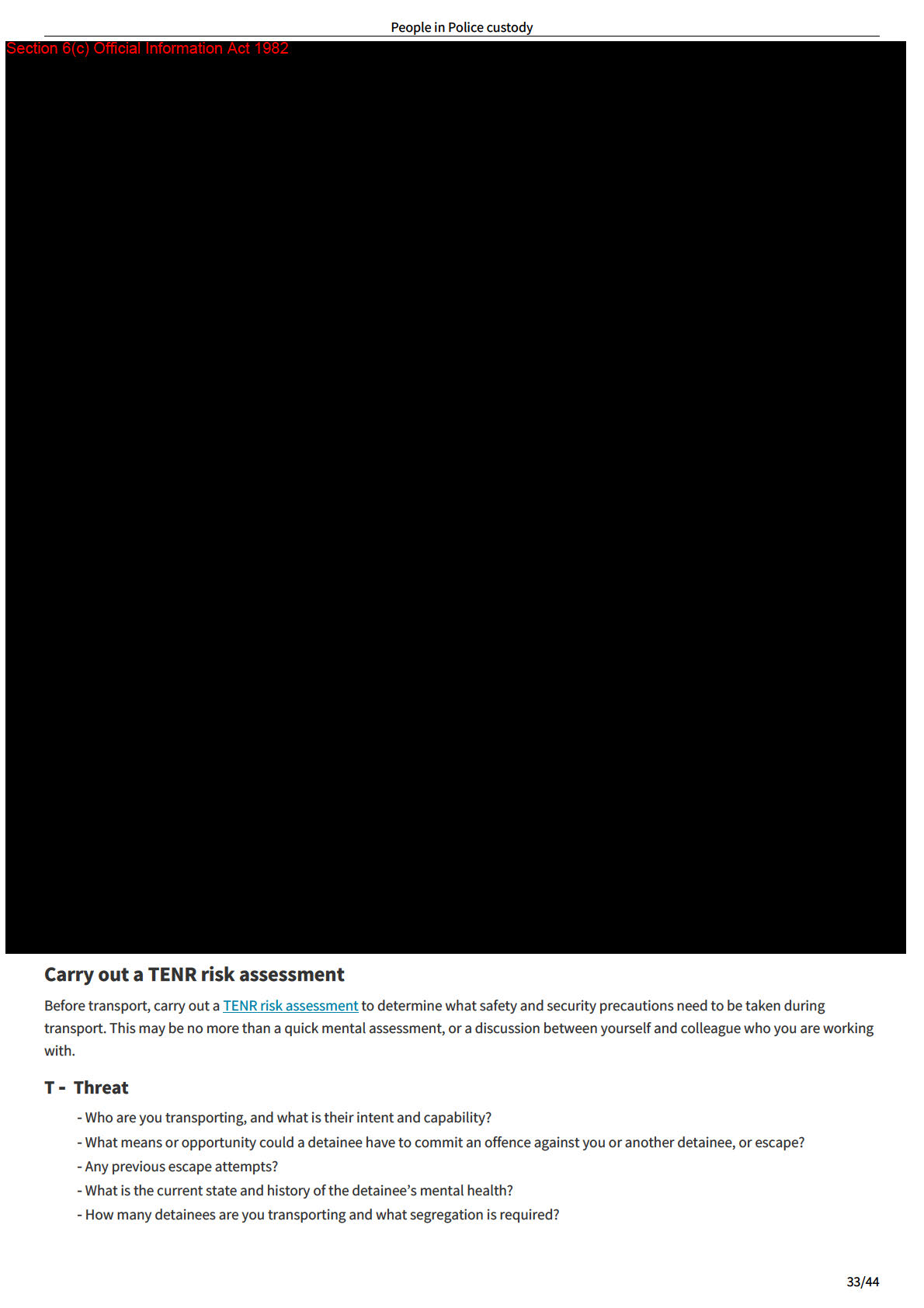
People in Police custody
‑ What is the capacity and capability of the vehicle you are using to reduce the threat?
‑ What is the time and distance that you have to travel, and could this contribute to the threat level?
E ‐ Exposure
‑ Who is exposed ‐ Police employees and other detainees?
‑ Consider exposure when segregating detainees from others.
N ‐ Necessity
‑ Consider the necessity to complete the transport now, or delay. If a detainee is behaving in a violent manner, consider a delay
until they are no longer a threat.
‑ Is it necessary to transport all detainees at once if safe segregation cannot be achieved, or could another vehicle or another trip
achieve the desired outcome?
R ‐ Response
‑ Formulate your response to manage the threats using all tactics and resources available to you.
When alternative providers are used
Where an alternative transport provider (Air, Sea) is used, a risk assessment must be carried out with that provider.
Additional risk factors for Department of Corrections prisoners
If the detainee is a Department of Corrections prisoner, take into account the level of external risk Corrections has assigned for the
prisoner’s security classification ‐ Minimum, Low, Low‐Medium, High and Maximum Security
If uplifting a prisoner from Corrections do your best to segregate in accordance with Corrections segregations if possible. If
segregation is unable to be achieved, communicate this to the Receiving Office staff. Assess the risks of transporting without
segregating. Options may include:
‑ providing an additional transport
‑ requesting Corrections to transport the prisoner
‑ electing not to segregate based on a risk assessment
‑ leaving the prisoner at the prison.
Further information on Corrections segregation can be found in Schedule 10 of the MOU with Corrections.
Who is to accompany a detainee on transfer?
As above, a TENR risk assessment must be conducted before every detainee transport and re‐assessed during transport.
Following this risk assessment, the appropriate number of employees, and the appropriate mix of Authorised Officer and constabulary
staff, should be determined to ensure both the security of the detainees, and the safety of Police employees and detainees.
Risk assessment should be conducted by the escorting employee(s). If agreement as to the level of risk mitigation cannot be reached,
then this should be escalated for supervisory review, and recorded by way of notebook.
Ensure the detainee has been properly searched
A detained person should have been searched following arrest and/or detention. Prior to transport, you may conduct a search
pursuant to s11(3) Search and Surveillance Act 2012 if:
‑ the person was not searched before they were locked up; or
‑ you reasonably
suspect that they have been close to another person who has not been locked up in Police custody; or
‑ you reasonably
suspect that they have been close to another person who has been locked up but not searched yet; or
‑ you have reasonable grounds to
believe that the person may have anything that may be used to harm themselves or others.
Ensure that items such as shoelaces, belts, jewellery, and any clothing items with cords, are removed to prevent self‐harm or harm to
another.
34/44
